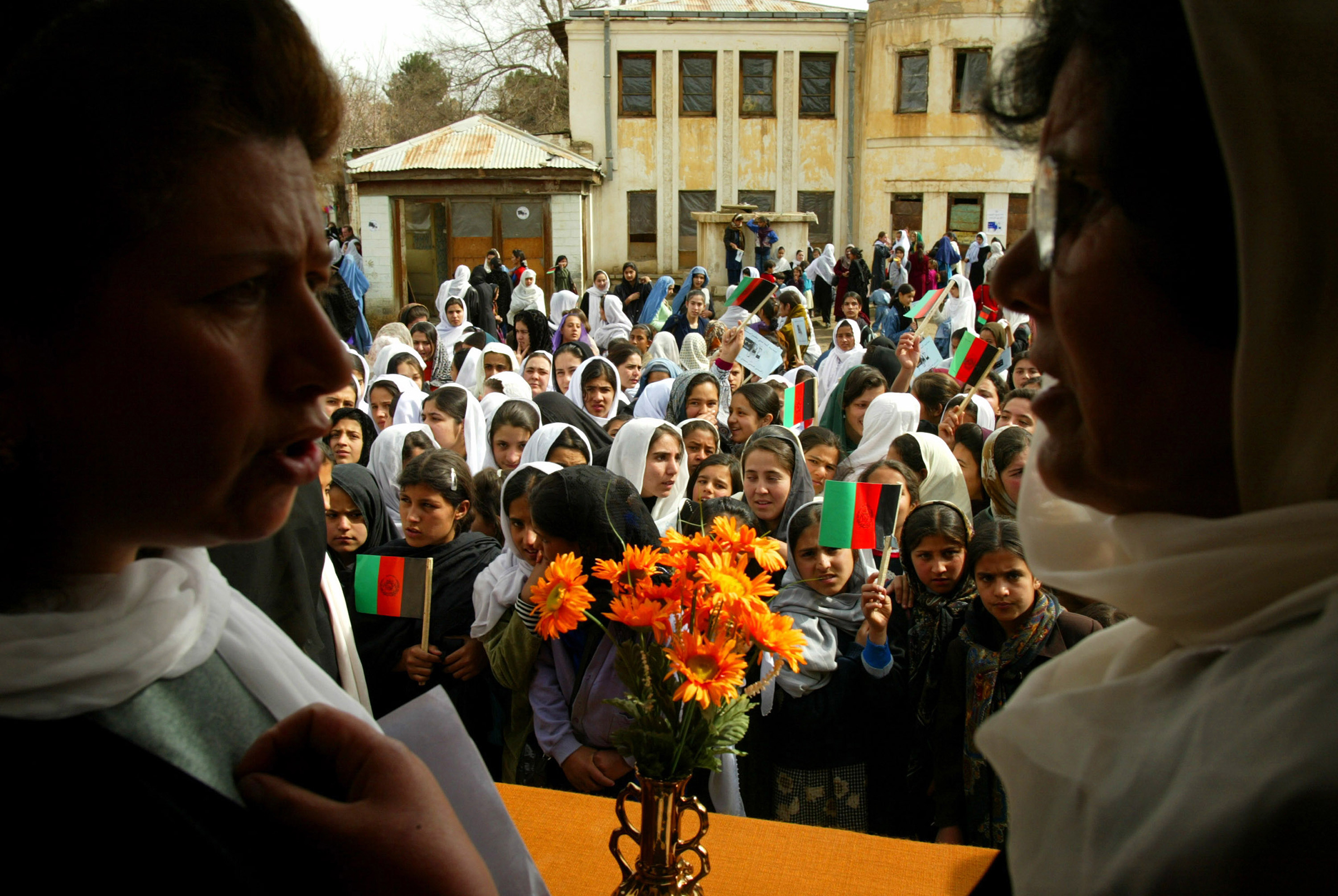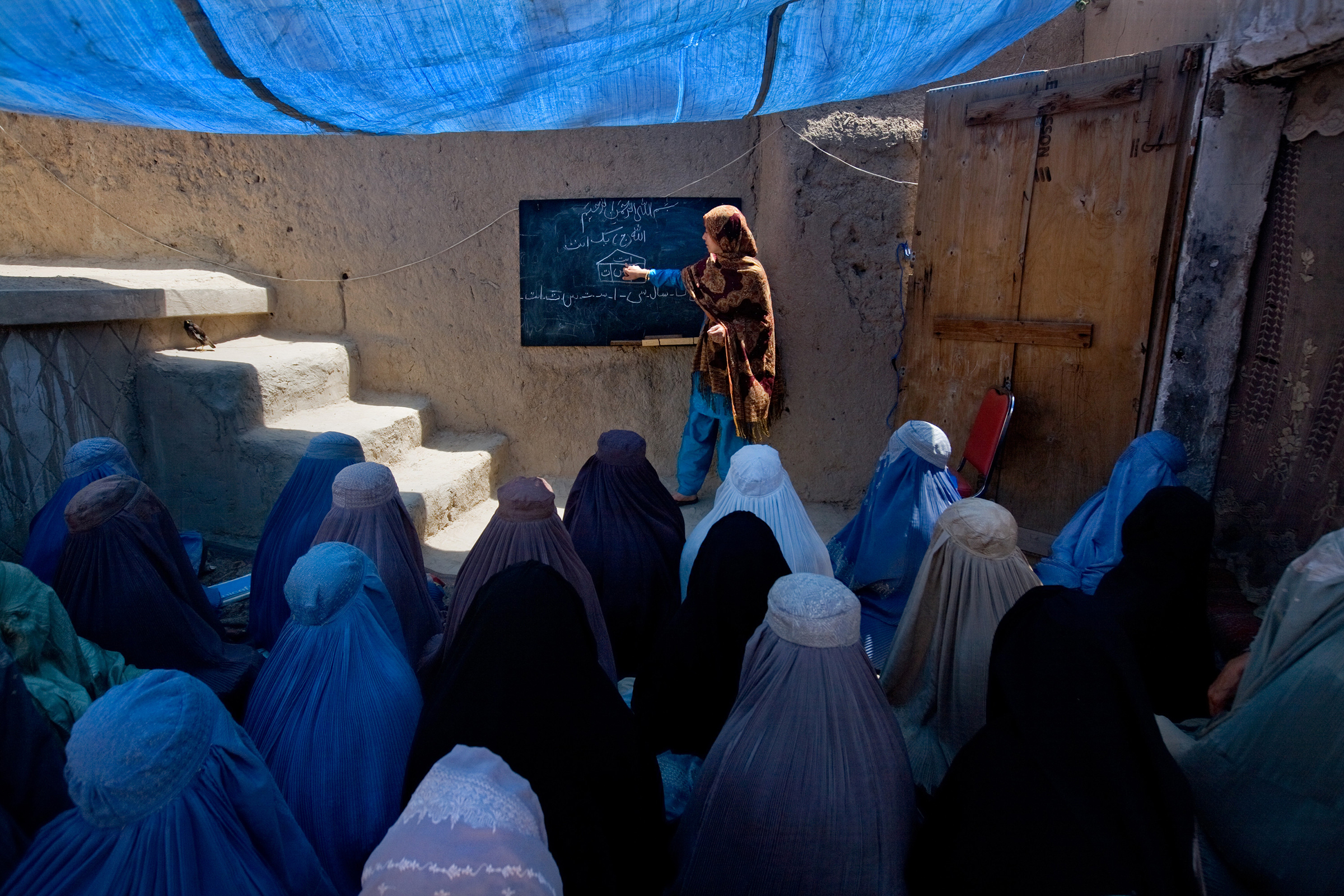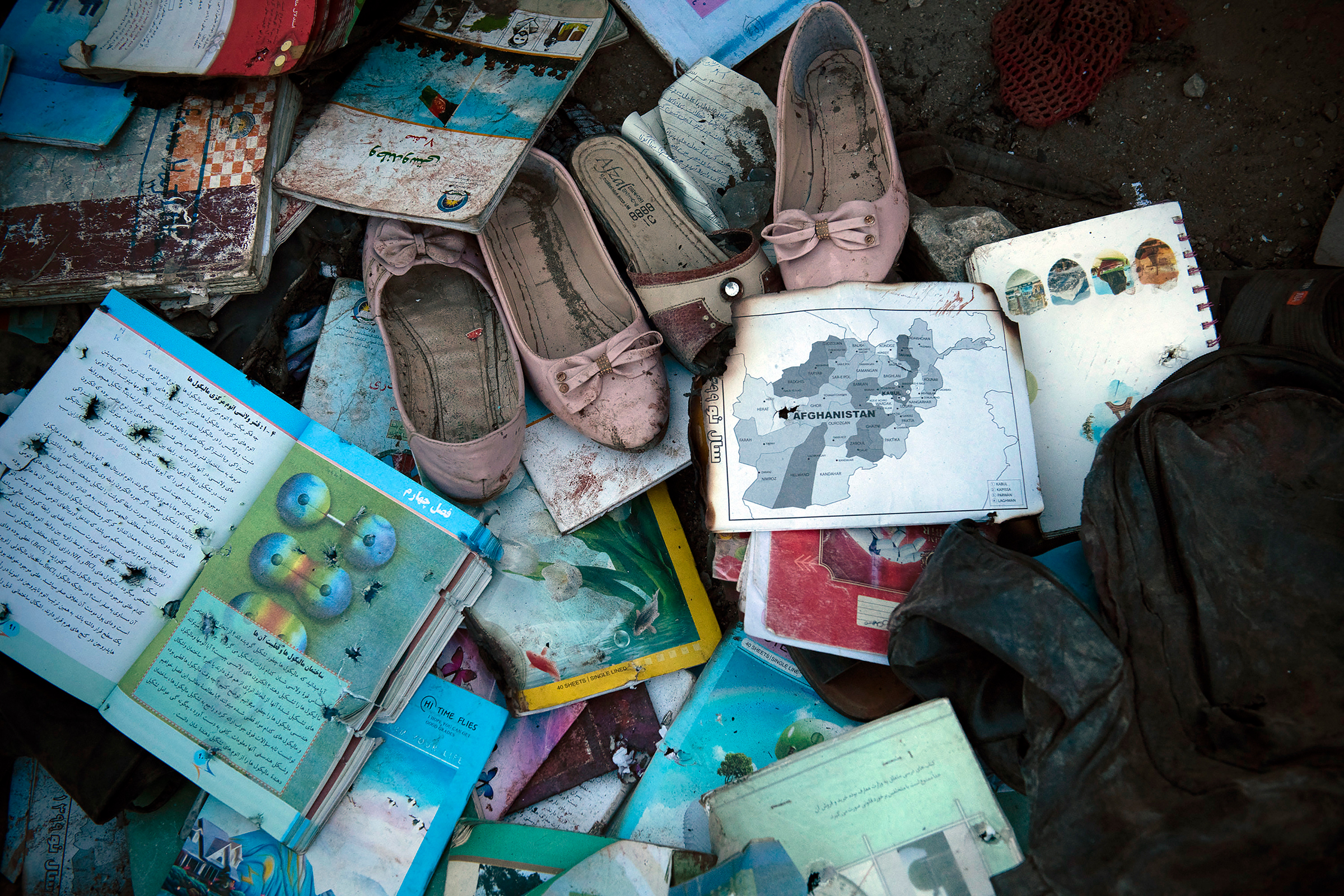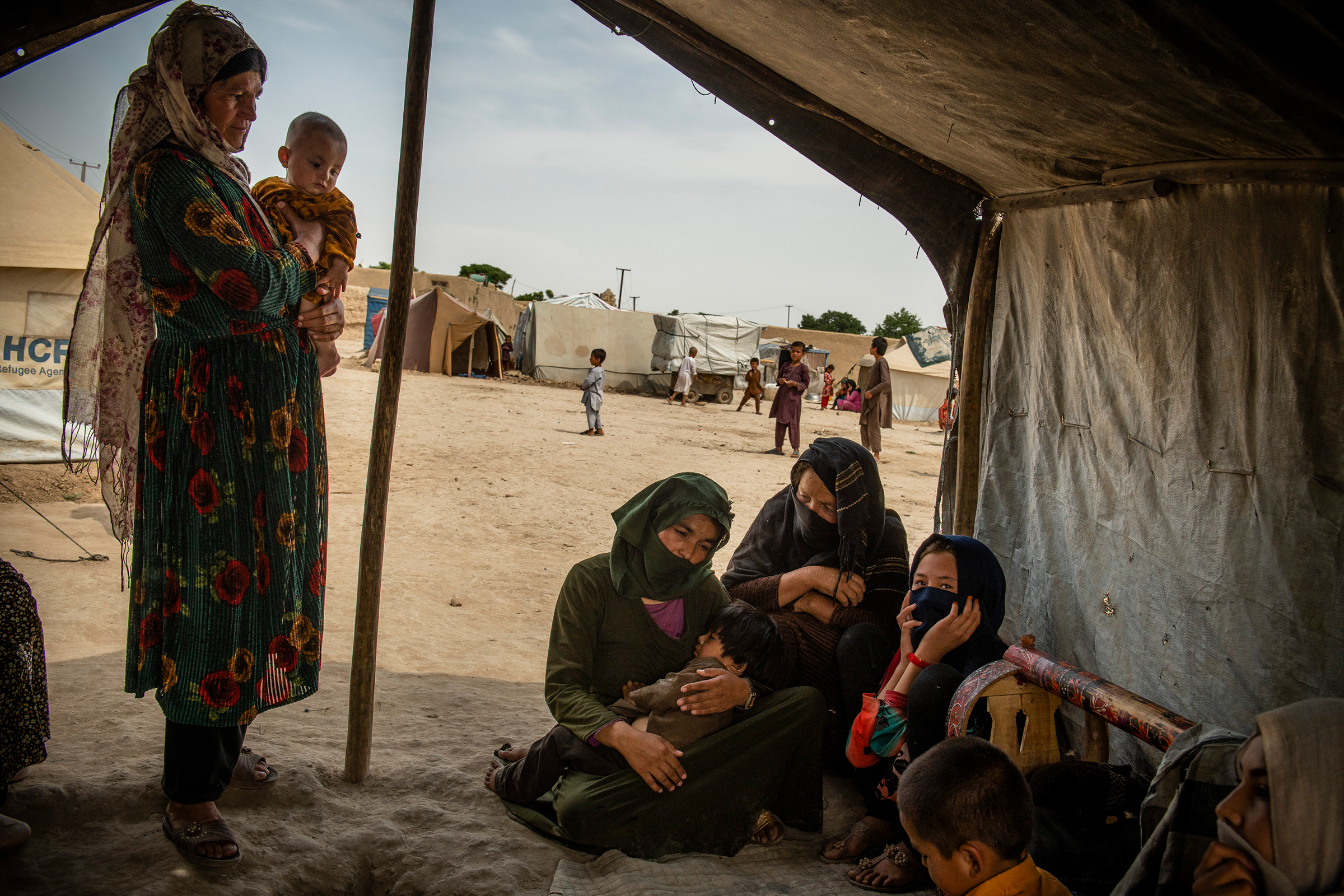Published in partnership with The Fuller Project, a global nonprofit newsroom reporting on issues that affect women, and Rukhshana Media, an independent Afghan news agency reporting on women
Before the Taliban started to dominate her district in western Afghanistan two years ago, Nadia was busy. When she was not teaching grown women how to read and write, traversing a patchwork of seventeen villages armed with little more than a few books, she was holding workshops for their husbands on women’s rights.
But once the Taliban killed the local governor in 2019 and got wind of Nadia’s program, they began sending death threats via religious officials and members of the local government. Once, insurgents shot at her car, narrowly missing her and injuring her husband. Another time, she and her children ran for their lives when armed men opened fire on them not far from her home. She moved her literacy courses underground, and started teaching a handful of women in her home.
But not long after President Joe Biden’s mid-April promise this year to withdraw all U.S. troops by Sept. 11, a senior local official reached out and told her to be extra careful, forcing Nadia to make a choice. She decided the risks to her life, and to her family, were no longer worth taking.
Now the 42-year-old teaches no one.
“We are threatened, we are banned from our activities, we are not authorized to work,” says Nadia, who asked to be identified by a pseudonym due to security concerns. In late April, Nadia fled her native Zendeh Jan district in western Afghanistan near the border with Iran, banking on anonymity in the bustling provincial capital city of Herat, where she now rents a house.

As the United States and its NATO allies withdraw their final troops and contractors, ending America’s longest-ever war, fears are growing about what happens to the country after. Many Afghans say they expect that the Taliban will return to power, either via a power-sharing deal with the Afghan government or through sheer force. The group already controls around half the country, ruling by its own definition of Islamic law. And there is widespread fear that if they do, the Taliban will reintroduce its notorious system of gender segregation from when the group ruled in the late 1990s, which barred girls and women from almost all work, the right to vote and access to education.
Messages of reassurance from Washington have been in short supply. The U.S. last week quietly vacated its Bagram air base, once the epicenter of the American war, without notifying the Afghan soldiers on guard, Afghan military officials said. Speaking to reporters ahead of the July 4 weekend, Biden said “The Afghans are gonna have to do it themselves.”
The plight of Afghan women and girls occupied much of the Western rhetoric around the 2001 invasion of Afghanistan, accompanying the stated aim of eradicating al-Qaeda for its role in staging the 9/11 attacks. Educating Afghan girls, a rallying cry of former first lady Laura Bush, in particular, became a U.S. focal point in Afghanistan. Soon after the U.S. invasion, tens of thousands of schoolgirls garbed in black uniforms and flowing white headscarves began attending schools across the country, symbols of tangible progress that are still touted by the international community today.
Almost twenty years on, teachers like Nadia, and their students, are grappling with what could be the end of education for generations of women and girls in Afghanistan. In interviews with TIME, The Fuller Project and Rukhshana Media, female teachers, students and local officials in Taliban-controlled parts of western Afghanistan say that the powerful insurgent group has over the last year already cut access to school for thousands of girls, especially teenagers.
If the scant gains won by women and girls in education disappear, it could have wide-reaching ramifications, from the role women play in shaping their country’s future to donor support that keeps Kabul’s hospitals open and government workers paid.
Experts see the treatment of women and girls by the Taliban as a barometer of the group’s future actions as they take over large swaths of the country. The restrictions on education could only be the beginning of a large-scale rollback of women’s rights in Afghanistan.
“After the foreign forces leave, I think schools and universities will close their doors to women,” Nadia says, describing how her classes reached impoverished adult women for whom education had been unobtainable, and women who lived too far from the nearest school. “[The extremists] spread the propaganda that if your daughters go to school, you will become infidels.”

The warnings pile up
Girls’ education was once a pinnacle of success of foreign intervention, a signature achievement heralded by Washington as key to winning ordinary Afghans over. When U.S.-backed forces ousted the Taliban from power, in 2001, there were almost no girls in school across the country. Today, there are millions, and tens of thousands of women attending university, studying everything from medicine to miniature painting.
According to World Bank data, the number of Afghan girls attending first grade peaked in 2011, the second year of former President Barack Obama’s troop surge, at 65%. While statistics on the number of Afghan children in school are difficult to obtain and often contested, all indicators show girls’ education is in decline. By 2015, female first graders had fallen to 57%, the most recent data available. Current literacy rates reflect the disparity between the genders: only 37% of teenage girls can read and write, compared to 66% of adolescent boys, according to Human Rights Watch. Today, UNICEF says of the 3.7 million Afghan children out of school, 60% of them are girls.
Melina, a recent high school graduate in Herat’s Obe district, a far-flung, mountainous area captured by the Taliban from the Afghan government in June, says she barely managed to complete her own education this past year. As Taliban forces gained control of her area over the last two years, the warnings piled up.
“One day, we found burial shrouds that the Taliban had sent to our school, saying ‘any girl continuing school will wear these,’” said Melina, who asked that only her first name be published. She still plans to go to university in Herat.
In the middle of May, after the Muslim Eid-al-Fitr holiday, her 13-year-old sister’s school shut down after receiving written threats from the Taliban. They ordered all classes for girls her age to cease. An official at Afghanistan’s Ministry of Education, who spoke on condition of anonymity, confirmed that a local Taliban commander had ordered schools teaching girls above grade seven in the district to close, the age a girl tends to enter puberty.
Read more: Why Afghanistan Is Still the Worst Place in the World to Be a Woman
Another 18-year-old schoolgirl, who did not wish to be named, fearing for her life, says her high school in Injil district bordering Herat city received “pamphlets and letters” at night in April, ordering them to stop teaching girls. They carried the seals, signatures and stamps of the “Islamic Emirate,” the name the Taliban uses for itself.
In the central Pashtun Zarghun district, a teacher who only gave her last name, Karimi, says insurgents have shut down girls’ schools with male teachers, a common occurrence across the country. “No man has the right to enter female educational centers,” she says.
The Taliban have made quick territorial gains throughout the country since U.S. troops began leaving Afghanistan, including seizing at least 80 districts of the country’s approximately 400 since May 1, according to a tally by the Foundation for Defense and Democracies’ Long War Journal. More than one thousand Afghan security forces fled north into Tajikistan since last week.
Soon, beleaguered Afghan security forces will be left to fend off the Taliban and other extremist groups without any NATO firepower. In recent months, nonstate actors from the Taliban and groups aligned with Islamic State have targeted and killed a slew of women in the public eye, from journalists to health workers.
In early May, insurgents targeted students leaving school in Kabul, killing at least 90 people, most of them schoolgirls from the Shi’ite Hazara minority, an ethnic group long persecuted by the Taliban. Bloodstained backpacks and charred notebooks lay strewn among their dead bodies. The Taliban denied responsibility for the attack and condemned it, but stopped short of heeding calls by the Afghan government and Washington for a permanent cease-fire. The Afghan president, Ashraf Ghani, blamed the Taliban, which pointed the finger at Islamic State.

In almost all places where the Taliban rule, school is, at most, restricted to girls before seventh grade, when they are around 12 years of age. Official school uniforms are out. For girls, they are replaced with full-body burqas and niqabs, a veil that covers the face except for the eye area; for boys, the shalwar kameez, a long tunic and baggy pants. More hours are dedicated to the teaching of the Quran than before.
For now, the Taliban use state-provided textbooks, but shadow education officials call the shots with supplemented religious materials and separate committees for schools. “Local people and elders talked [in March] with Taliban members, trying to convince them to let girls continue their education higher than seventh grade,” said Tor Mohammad Zarifi, a former member of Herat’s provincial council. “But, unfortunately, they were rejected.”
For the teacher Nadia, the repression has been gradual as her region’s security situation deteriorated over the last two years. As more Afghans sided with or surrendered to the Taliban—many out of a need to survive—her activities have come under sharper scrutiny.
Where they are not threatened, girls are dissuaded from attending school, the buildings heavily damaged or used as bastions in fighting between Taliban insurgents and Afghan government forces. The number of girls registered to take the kankor, the annual university entrance exam in May, dropped in parts of Herat compared to the past, warn local officials from the province. At Herat University, there are several hundred fewer teenage girls compared to last year, according to its vice chancellor for student affairs, Mohammad Dawood Munir. “The more a district is insecure and in conflict, the more deprived the girls are,” he said.
In recent months at Taliban-controlled checkpoints across the country, human rights groups have observed insurgents blocking women, including supervisors of education facilities, from traveling without a mahram, largely understood to be a male relative over the age of 16.
“Just a few months ago, many of our female colleagues were able to travel with their mother as a mahram,” said Terje Watterdal, country director of the Norwegian Afghanistan Committee, a nonprofit focusing on health and education that has worked in Afghanistan since the 1980s. “That is no longer possible.”
This week, local journalists in Firoz Koh, the capital of the central Ghor province, circulated a photograph of a leaflet reading “Dear sisters, observe the hijab and do not walk around the city without a mahram.” Beneath the text are two headshots of a woman. One depicts a burqa, and has a green tick beneath it. The other shows a woman’s face framed by a black headscarf, and is covered by a large red cross. The top of the leaflet bears the insignia of the Taliban.

Education ‘is the first thing to be sacrificed’ by the Taliban
The United States has warned that any future international recognition or U.S. aid, on which the Taliban will be partially dependent, is conditional on their treatment of women and girls. “We will use our full diplomatic, economic, and humanitarian toolkit to support the future the Afghan people want, including the gains made by Afghan women and girls,” a State Department spokesperson said in emailed comments.
In November, the European Union along with the United States and most other major donors, co-authored an advisory paper containing 10 conditions for aid, including women’s rights and access to education, designed for both the Afghan government and the Taliban.
Yet donor support, which currently makes up 75% of the Afghan government’s budget, is rapidly declining. Commitments from the United States, the European Union, Germany and the United Kingdom are, at best, in flux, and at worst, dropping steadily. The coronavirus pandemic is further squeezing budgets. At a conference in Geneva last year, donor pledges for Afghanistan for 2021-2024 were between $12-13 billion, at least $2 billion less, or a drop of around 20%, than the four-year period before. The U.S. has earmarked $600 million in humanitarian aid for the country this year.
The hundreds of billions of dollars spent fighting the war in Afghanistan has resulted in huge advancements for Afghans, and allowed women especially to thrive in media, government, education and civil society. But many gains have been incremental, and insufficient. Most Afghans live in poverty, the country has one of the highest maternal mortality rates in the world and there are millions of girls who never went to school, even for a day. “There is no political will to make sure we don’t stop basic services from ending,” said Ashley Jackson, Co-Director for the Centre of Armed Groups at the Overseas Development Institute (ODI), a global affairs think tank. “I think a lot of donors have checked out. First you had the pandemic, and a lot of embassies evacuated and never returned.”
In April, the United States said it was withdrawing “nonessential” personnel from its Kabul embassy. A month later, Australia abruptly announced it was closing its embassy over fears of violence, and others in the heavily fortified diplomatic area are scaling back.
“The U.S. has emboldened [the Taliban] to tighten the noose,” Jackson continued. “And there are some areas where the Taliban doesn’t care less, and that’s women’s rights and girls’ education. It is the first thing to be sacrificed.”
When Taliban leaders were negotiating a peace treaty with the U.S.-backed Afghan government last year in Qatar, they sought to reassure key international players that they had reformed their brutal ways of the past. Gone were the elusive figures of twenty years ago. Now the Taliban was internationally savvy with a sophisticated press and public relations team. In recent years senior Taliban members have been feted by government officials for peace talks in Doha and Moscow, driven in chauffeured cars with blackened windows and visited high-end hotels — much that befits a regular diplomat.
Read more: Inside the Backroom Deals and Secret Annexes of the U.S.-Taliban Peace Talks
But despite the outward transformation, the Taliban has, perhaps intentionally, offered scant details on how they would actually rule the country of some 40 million people if and once they regain control. They have said girls are allowed to attend school, women can work and be in public life, but this must all abide by “Islamic injunctions”, murky phrasing which gives leeway to individual interpretation by local commanders. “Unfortunately I’m not very optimistic that the Taliban will change,” said Sima Samar, the former chair of Afghanistan’s independent human rights commission. “The areas under their control do not reflect the claims of a change in the Taliban’s mindset on women’s rights.”
A major report by the ODI’s Centre of Armed Groups in February examined the Taliban’s policy — as it stands — on education and found very little guidance for female education. Of the 101 articles in the extremist group’s education manual, only two are dedicated to women and girls.
In short, the articles say education for prepubescent girls is important and must be mandated; for teenagers the situation is less clear, with several vaguely-described, “favorable” conditions needing to be first met in the areas of security and Islamic education.
Taliban spokesman Zabihullah Mujahid did not respond to repeated requests for comment. In an interview with Foreign Policy in June, Mujahid said the Taliban wanted “separation between girls and boys, women and men, in universities, schools or madrassas.”
But as the Taliban grows in clout and territory, the group is also realizing that it must curry favor with the local population in order to succeed at statesmanship, its desired goal. Millions of Afghans have grown used to being educated, alongwith their daughters and sisters, and evidence is emerging of a Taliban willing to adjust.
At the end of last year, the Taliban and UNICEF came to an agreement in which the insurgent group would open thousands of informal schools in parts of the country it controls, namely elementary schooling for boys and girls. The deal opened a new chapter for the Taliban in its quest for international recognition and legitimacy.
Watterdal holds weekly WhatsApp calls with Taliban officials, who, he says, have understood that in order for their communities to have midwives, women must be educated through twelfth grade. Most of the young women studying in his group’s education programs for health care workers come from Taliban-controlled communities, and have received the blessing of their community elders to attend. Two-thirds of all Afghan births take place at home.
“They are seeing the practical impact of some of their restrictive policies, that it actually hurts the health of their wives, their daughters, their sisters. So there is a realization that this has to change. And this is new,” Watterdal said.
Even still, Nadia, the teacher, says she has yet to see a changed Taliban. “I have not left the house in almost 10 days,” she says. Gone is the time when she would hop about her province educating women, she says. Instead, she’s a teacher with no pupils, piecing together a life in hiding.
Atefa Alizada is a reporter with Rukhshana Media, an independent Afghan news agency reporting on women. Another reporter with Rukhshana media, who cannot disclose her name due to security reasons, contributed reporting from Kabul.
Amie Ferris-Rotman is a contributing special projects editor with The Fuller Project, a global nonprofit newsroom reporting on issues that affect women.
More Must-Reads From TIME
- The 100 Most Influential People of 2024
- The Revolution of Yulia Navalnaya
- 6 Compliments That Land Every Time
- What's the Deal With the Bitcoin Halving?
- If You're Dating Right Now , You're Brave: Column
- The AI That Could Heal a Divided Internet
- Fallout Is a Brilliant Model for the Future of Video Game Adaptations
- Want Weekly Recs on What to Watch, Read, and More? Sign Up for Worth Your Time
Contact us at letters@time.com
